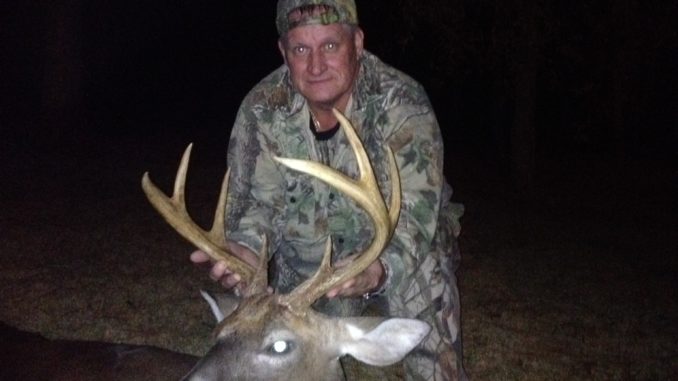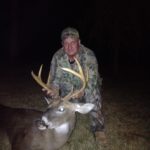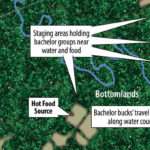
Food and water will lead hunters to good concentrations of September whitetails.
At the beginning of the deer season, most outdoor devotees are making waves in their favorite fishing spots, reeling in a redfish, king mackerel or Arkansas blue. For hardcore deer hunters across the Palmetto State, the sweltering heat, mosquitoes and snakes won’t keep many from climbing into a tree stand. Unknown to many, early September is an ideal time to pick off a trophy buck.
The beginning of the rut is still weeks away, so bucks will still be traveling in bachelor groups, gallivanting in their summer patterns without a care in the world. It is a perfect time to ditch the fishing rod and get into the woods to get that buck before his hormones slingshots him onto the neighbor’s property.
Biologist Charles Ruth, deer project supervisor with the S.C. Department of Natural Resources, said bucks will be in bachelor groups into the early fall.
“Although many hunters do not know it, bucks are actually very social outside of the breeding season,” says Ruth. “They form bachelor groups early in the year — when competition related to breeding is not going on — that hunters often see in late summer.”
The onset of breeding behavior is the primary reason why bucks break out of their social circles.
“In South Carolina, bucks will break up from their bachelor groups after the shedding of the velvet when their testosterone levels increase,” Ruth said.
Between June 21 and Dec. 21, the year’s longest and shortest days, the amount of daylight, aka the photo period, becomes progressively smaller. According to Ruth, a buck’s testosterone level begins to rise as a result of a shortening photo period, and he starts his cycle. That’s when bucks split up and start hunting down receptive mates.
The identity of specific individuals in a bachelor group of bucks depend on a variety of factors. According to Ruth, there are no hard and fast rules.
“Bucks share home ranges that allow for familiarity with each other,” he said.
Typically, most bachelor groups will have anywhere from three to five members of various ages, but it wouldn’t be unusual to see a bachelor group with as many as eight. Bucks can still be seen together throughout the season, even after the rut begins, but this should not be mistaken for a friendly group of bachelors hanging out together.
“The desire to breed is strong, as is the lack of tolerance for other males during the rut,” Ruth said. “With that being said, hunters often see more than one buck around a doe in heat, but this is typically coincidence rather than a bachelor group.”
As soon as hunters begin noticing rubs and scrape, pre-rut activity has started, and the bucks will break up and begin looking for mates.
Hunters can have success during the early season when a complete lineup of bucks is still walking the forest. Finding bachelor groups before the onset of breeding behavior is fairly easy, and hunters must learn how and where to find them.
T.J. Hallman, plantation manager of the Territories at the Saluda River Preserve in Chappells, connects the environmental conditions with the needs of the deer to locate his early season deer.
“Bucks are going to endure the late summer days where they can keep cool, get the necessities and not waste energy maintaining everyday life,” Hallman said. “Daily life for a buck is priority No. 1.”
Hallman finds his biggest bachelor groups confined to hardwood drainage corridors where water, food and cover are available in a very small area.
Beyond hardwood drainages, South Carolina is 35th in the nation for agricultural crop production. Over 4.8 million areas are cultivated with a wide range of products from corn to tobacco. But the hundreds of thousands of acres of peanuts and soybeans are prime destinations in the early season for deer and perfect places to set up a stand. The green foliage of peanut and soybean plants are prime summer foods, loaded with protein. Other than farmers making every attempt to keep them out of the fields, deer are on easy street, with tons of food available and almost no pressure at all.
Bachelor groups will use agriculture fields on a daily basis through the late summer and into early fall, and that can lead to their downfall for a crafty hunter privy to their daily patterns.
A solid food source is a prime place to encounter bachelor groups in September. It can be an agriculture field, but a productive food plot, a wooded corridor loaded with persimmon trees and early acorns or an oasis created by hunters with mineral blocks, feeders and water will also bring them in.
Hallman said bucks can be more-easily patterned this time than any other part of the season because their needs are completely covered from available resources.
“There is a distinct pattern of where and when bachelor buck groups visit certain locations throughout the late summer and into the early part of hunting season. Bachelor bucks will stay on a regular schedule. We use salt/mineral sites along with food sources,” he said.
Keeping track of the bachelor bucks is critical when opening day approaches.
“We always have a few bachelor groups that show up on camera during the middle of the day, but you can almost bet the farm on the first hour after daylight and the last hour before dark, when temperatures are cooling down, to bag that opening week buck,” said Hallman, whose experience in the Upstate is that late-season patterns mean opening week archery kills.
“As long as bucks aren’t alerted to your presence, you have about two weeks to peg a good buck in his summer pattern before the bucks break apart and start rutting. It is my favorite time of year to hunt. Bucks are easy to pattern, temperatures dropping, and it is time to kill a big buck.”






Be the first to comment